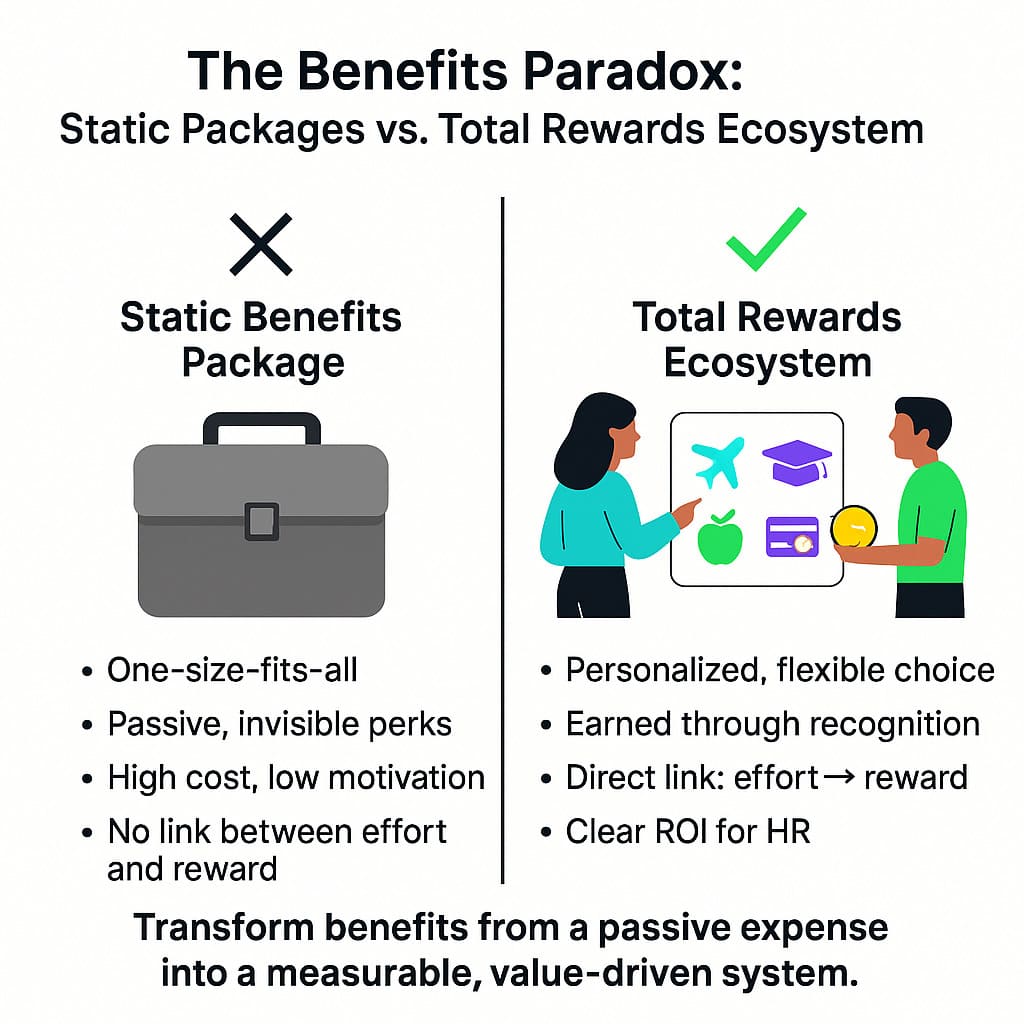The Benefits Paradox: Why Your Best Perks Are Having No Impact
- The High Cost of Invisibility
- From Entitlement to Earned Value: The Psychology of Choice
- Building a Total Rewards Ecosystem
Executive Summary
European companies are investing more than ever in comprehensive employee benefits packages, yet are seeing diminishing returns in motivation and engagement. This paper argues that the issue is not the value of the benefits themselves, but the outdated, passive model of their delivery. When benefits are disconnected from an employee’s daily contributions, they are perceived as an entitlement rather than a reward, leading to what we term the “Benefits Paradox”: a high-cost, low-impact system. We propose a strategic shift from a static benefits package to a dynamic “total rewards” ecosystem. In this model, employees convert their recognized contributions into a personalized selection of benefits, transforming a passive corporate expense into a powerful tool for reinforcing desired behaviors. This approach not only increases the perceived value of existing benefits but also provides leaders with a clear, measurable return on their cultural investments.
The High Cost of Invisibility

Across the Nordic region and Europe, leaders are allocating significant budgets to attract and retain talent through competitive benefits, from extensive health coverage to wellness stipends. Yet, a common frustration echoes in boardrooms: “people just sometimes don’t know what they have.” This isn’t an anecdotal complaint; it points to a critical flaw in the traditional benefits model. When perks are delivered as a uniform, passive package, they become part of the background—an expectation, not a motivator.
This creates a dangerous financial leak. Companies suffer from what appears to be a costly benefits program that doesn’t actually motivate. The investment becomes a sunk cost, failing to impact the metrics that matter: productivity, engagement, and retention. The core problem is a disconnect between action and reward. An employee receives the same benefits package whether they have had a breakthrough quarter or a mediocre one. This passive delivery system fails to create the positive feedback loop necessary for sustained motivation.
From Entitlement to Earned Value: The Psychology of Choice
The solution is not to offer more benefits, but to fundamentally change how they are accessed. The key is to transform benefits from an entitlement into something employees earn and choose. This shift is rooted in established motivational psychology: when individuals have autonomy and can see a direct link between their effort and a desired reward, the perceived value of that reward increases exponentially.
By creating a system where employees accumulate points or a virtual currency for recognized contributions—collaboration, innovation, completing training—and can then “spend” this currency in a marketplace of benefits, you achieve several critical objectives:
- It makes benefits visible again: The act of choosing a benefit from a marketplace forces employees to actively engage with and appreciate the perks the company offers.
- It connects effort to reward: The system creates a direct, tangible link between an employee’s valuable contributions and the rewards they receive.
- It introduces personalization at scale: Instead of a one-size-fits-all approach, employees select the benefits that are most meaningful to them, dramatically increasing their value and impact.
Building a Total Rewards Ecosystem
Implementing this model requires moving from a simple benefits list to a dynamic total rewards ecosystem. This is more than a flexible benefits plan; it is an integrated system where recognition and rewards are intertwined.
In such an ecosystem, the company’s investment in benefits is no longer a passive expense but a pool of capital used to fuel a vibrant internal economy. Technology is the enabler of this transformation. Platforms like AlbiCoins provide the infrastructure to manage this economy, allowing for seamless peer-to-peer recognition, the awarding of points, and a customizable “benefits cafeteria” where those points can be redeemed.
This model gives HR leaders what they have always lacked: a clear, data-driven way to measure the ROI of their cultural initiatives. By tracking which benefits are chosen and how recognition flows through the organization, leaders can make informed decisions, optimizing their investment in the perks that deliver the greatest motivational impact. It’s time to stop funding benefits that don’t work and start building a system where every euro spent on your team generates a measurable return in engagement and performance.
References:
- Total Rewards in the Nordic Countries: A Comparative Study – This study from the University of Gothenburg provides a comprehensive overview of Total Rewards strategies in Sweden, Denmark, Norway, and Finland, analyzing how companies balance fixed and variable compensation with a wide range of benefits.
- Perceived Benefit Attractiveness and its Correlates: A Study among Finnish Employees – A Master’s thesis from the University of Jyväskylä that investigates what makes certain benefits attractive to employees, highlighting the importance of perceived choice and value.
- – This European study examines how flexible benefit plans can significantly increase employee satisfaction compared to traditional, fixed packages.
- Employee benefits: what’s best for your business? – An analysis from the IZA Institute of Labor Economics in Germany that discusses the strategic advantages of different benefit schemes for business performance and employee retention.
- Organizational justice and readiness for change in a Finnish healthcare organization – A study from the University of Helsinki that, while focused on change management, explores how perceptions of fairness in rewards and processes (procedural justice) are critical for employee buy-in and motivation.


